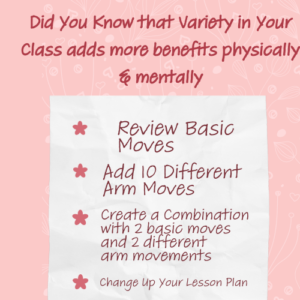(13 minutes) The pandemic has brought upon unprecedented challenges for our senior group exercise programs – particularly those individuals who were less active and less able bodied. Water exercise provides a unique opportunity to help this population especially when if the e protection and properties of the water are utilized.
As everyone gets back into regular programming realize that gentle mobility exercises and weight bearing exercises are needed for those coming to the programs for the first time or coming back from a long hiatus. Here are some tips to add into your programs to help with function and mobility – which is easily incorporated into a warm up.
We know that programs often have many skills, ages, health histories and personalities so be ready to help those who are simply needing gentle water exercise move and benefit in the water.
Question: Why Are Basic Movements so important to Aqua Fitness ?
Answer: Because each movement has a purpose!
Realize all basic movement is important – especially for seniors with weight bearing fitness in mind.
There are 7 basic moves to choose from in shallow water and with the feet off the pool bottom cycling or biking may be added when using a noodle or buoyancy belt -even in shallow water to replace more rebounding or jumping movements for those who cannot absorb and jarring on the joints.
So let’s review why a variety of movements must be introduced into the warm up and then re-used for cardio and muscle conditioning during the program -instead of only jogging movements.
For example – How many people get into the pool and walk using same arm-same leg??? Working arms and legs simultaneously will throw the body completely off balance. If a person needs to work on balance, they need to re-train coordination and oppositional movement such as walking.
Walking Forward, Marching/Jogging /Kicking forward and Cross Country Ski: are all oppositional moves used in the Sagittal plane – so important for injury prevention. Too many people break a hip or lose balance and fall on land because they do not swing their arms nor train opposition. Often they have not learned to balance properly. All of these moves re-enforce a correct arm to leg swing.
Be sure to start with walking in opposition (right hand may touch left knee, then left hand touch the right knee like a march then progress to a cross country ski movement for greater ROM (range of motion) to improve stride length and stretch out the hip flexors. Be sure to step back (not forward if you are showing a ski movement on the spot so you may extend and actively stretch the tight hip flexor muscles. Try to travel moves forwards or backwards -even if only a few steps -as excessive may not be possible during covid safety protocols.
JAX or Side Walking/jogging (frontal plane):
A JAX (like jumping jax on land) can be done using same arm same leg or in opposition (arms out and legs in) for getting the shoulders under the water and again training coordination and balance. Also the slide side out (walk side) movement is used to strengthen the hip abductors or outer thigh muscles which are critical for stabilization of the hip joint required for safe walking and injury prevention on land.
Rocking: May be and excellent movement for learning weight transfer (step forward on one leg then step back on the other leg or step side and lean slightly on one leg then transfer weigh to the other leg. Rocking is easily practiced and learned with forward to back or side to side or even diagonal movement patterns. In other words, the exercise utilizes all three planes of movement which simultaneously engages the abdominal core for balance.
The purpose of rocking movements are to learn how to transfer your body weight which helps to prevent falling . Training in water helps to improve function and weight bearing on land. When you rock forward you immediately use the core musculature to stop a fall. The same applies to rocking side to side – you go to one side then immediately reverse to going back to the opposite side. (Internal Obliques)
Rocking on the diagonal can be done using a series of rocking movement to one diagonal then the other or alternating diagonal to diagonal. This engages the External Obliques.
More importantly any of these moves engage the core stability muscles – think of how many people come to class with back problems -so you are helping them to stay strong!
Kicking: May be performed from the knee and hip keeping the knee joint soft or not locked. Kicking forward to elongate the knee stretches out the calves, hamstrings and gluteus maximus muscles – a group of naturally tight muscles. Additionally, kicking from the knee will strengthening the quadriceps (front thigh) and anterior tibialis (lower leg) muscles. The tibialis anterior muscle lifts the foot up which is key for walking function. This is especially important to prevent tripping when walking. Kicking forward and travel this movement backwards can be used to introduce the action-reaction property of water to show the assistance of water. Kicking and going forward will strengthen both muscles groups and introduce resisted travel to your participants. –
Jumping: Anyone with back problems needs to stretch out the lower back especially during the warm up. This can be done easily and safely facilitated keeping the shoulders under the water (neutral working positions) and push the legs up in a knee tuck or frog jump. Simply keep the shoulders submerged under the water and jump to lift one or both knees and hold under the knee to feel the stretch. Repeat several times. Cue to keep the shoulders submerged and you will again engage the abdominal core.
Cycling: Using a noodle (in front of the body or seated on the noodle like a bicycle) provides movement without vertical stress or impact on the joints. Cycling may be performed in either shallow or deep water. In shallow water depth the feet may be used to contact the pool floor when necessary for anyone who may feel nervous or a non swimmer. Cycling with the legs out in front of the body like on a recumbent bike is especially good for anyone with knee or lower back problems.
If your participants understand how each movement can help them they will put more into their workout, improve their health and stamina and keep coming back for more.






